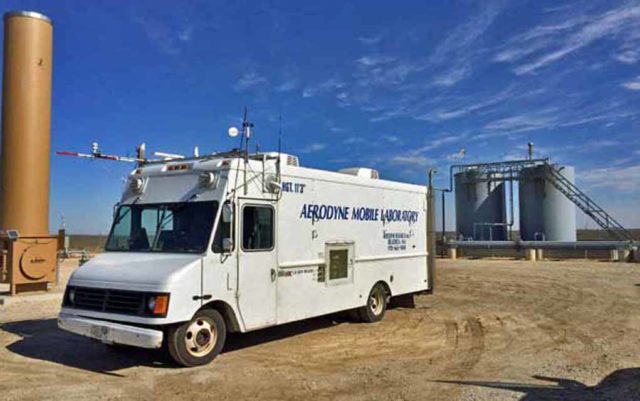
On any given day, emissions from oil and gas activity in Colorado can make a big enough contribution to ground-level ozone levels that it pushes the region out of compliance with Environmental Protection Agency (EPA) health standards. That’s according to a study led by the University of Colorado Boulder Cooperative Institute for Research in Environmental Sciences (CIRES) and National Oceanic and Atmospheric Administration (NOAA) researchers published on Nov. 3 in the journal Elementa.
Data for the study was culled from research conducted during the summer of 2014 near oil and gas operations in Greeley.
“Our biggest takeaway was that on individual days out in Greeley, out in the gas field, oil and gas can contribute up to 20 to 30 parts per billion [ppb] to ozone production, which is a significant amount,” says Lucy Cheadle, who led the work as a CIRES research associate working in the NOAA Earth System Research Laboratory.
The EPA limit is currently 75 ppb per day. The study found that there is about 45 to 55 ppb of ozone present in the air on an average summer day along the Front Range, due to a variety of sources. Thus, a 20 to 30 ppb spike in ozone could push it over the limit.
In the course of 14 days, ozone levels exceeded the 75 ppb limit once, the study found. That’s important because ozone builds and dissipates every day, and so looking at its peaks might be more useful for regulators than looking at the average, which Cheadle says most studies have typically done.
“Say you take the average contribution of oil and gas. It might be lower than what we found. It might be whatever percent it is, or some study found 3 ppb on average, which you look at it and the oil and gas industry is like, ‘Sweet, 3 ppb.’
“But the EPA doesn’t regulate on an average basis, so if you have four or five days where [ozone] is really high and oil and gas is the significant contributor, which we found on one day out of a 14-day period, that is still an important thing to regulate.”
Ozone is created by the combination of volatile organic compounds (VOCs) (oil and gas’s main contribution), nitrogen oxides (the general population’s contribution, typically via cars) and sunlight. Ozone tends to dissipate by a day’s end because sunlight goes away, and nitrogen oxide can oversaturate the mixture. VOCs also come from agriculture, typically in the form of methane. What all this means is that on any given day there are a ton of variables that determine how much ozone will be created. And the weather not only plays a role in ozone production via how much sunlight there is; wind patterns can both help create ozone and transport it throughout the region.
The health effects of ground-level ozone vary from person to person, but it’s invisible and can lead to respiratory attacks. Generally speaking it’s not good to be exposed to levels over the EPA limit.
“The way the EPA makes their regulations is they do a lot of research on the human health impacts,” Cheadle says. “So they make what seem like weird rules based on … what is the most harmful to humans. I think ozone is especially [harmful] for sensitive populations, so if you’re older, or a kid, or you have asthma, you’re more likely to get harm from it, but it’s not good for you on one day to be exposed to it.”
Ozone has an impact on crops and other vegetation as well.
Cheadle says ozone is tangentially impacted by climate change — ozone is highly correlated to temperature and as days get hotter, there is potential to create more harmful ozone.
Another recent study, this one led by the National Center for Atmospheric Research (NCAR), culled from the data collected in 2014 and found that oil and gas and motor vehicles are the main contributors to ozone along the Front Range, and that ozone frequently is carried to high mountain climates. The data for that study and the NOAA/CIRES study was conducted via “aircraft, balloons, mobile laboratories and other ground-based facilities to characterize emissions from many possible sources.”
That allowed research teams to parse out VOCs so they could say with more certainty when oil and gas emissions were impacting ozone levels. For instance, if ethane was present in the air, which “we know is mostly emitted form oil and gas here,” Cheadle says, researchers could appropriately pin the culprit.
The northern Front Range has long had a problem with ozone levels, with a steady increase in the maximum ozone levels in and around Denver over the last few decades. And, every community along the Front Range from Colorado Springs to Fort Collins received an F in the American Lung Association recent annual air quality report because of ground-level ozone. Too, the NOAA/CIRES study found that it’s not only in metro areas where harmful ozone levels are being detected — rural areas near Greeley (and near oil and gas operations) also experienced high levels.
New EPA standards that would cap safe ozone levels at 70 ppb were passed in 2015, but the Trump administration’s EPA could stall enforcement of the new level. Regardless, it’s unlikely the Front Range will be able to meet those standards until at least 2020.














